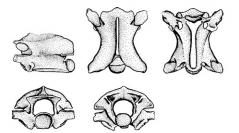

 Geodiversitas
22 (4) - Pages 559-588
Geodiversitas
22 (4) - Pages 559-588The diverse snake assemblage of the lower/middle Miocene (MN 4/5) site Vieux Collonges (France) includes Boidae (Python sp., Eryx sp., Boidae B & C), Colubridae (Texasophis sp., Neonatrix cf. europaea, Natrix aff. sansaniensis, Natricinae A, B, C & D), Elapidae (Micrurus aff. gallicus, Naja cf. romani, Naja sp. 1, Elapidae A & B) and Viperidae (Viperinae A, Vipera ["Oriental vipers"] or Daboia). The Boidae represent an "ancient" component of the snake fauna which was displaced from Europe by "modern" Asiatic and North American immigrants during the lower and the middle Miocene. Although the representatives of the family Boidae were still common in West Europe at the lower/middle Miocene transition (Vieux Collonges), the representatives of the Colubridae were predominant in Central Europe (Merkur, Dolnice, Petersbuch 2) already during the lower Miocene. It may be possible that the first Colubridae have immigrated into the Central European areas across the Mazury-Mazowsze continental bridge (Poland) in the lower Oligocene and then penetrated into West Europe across the Rhine Graben in several waves of dispersal. The small representatives of family Elapidae appeared in Europe most probably slightly earlier (MN 3a) than the large representatives of the genus Naja commonly present at Vieux Collonges. Similarly, for the oldest European viperids are typical small vipers, the large "Oriental" vipers appeared later (MN 3) in Europe. Concerning Vieux Collonges, the representatives of the Viperidae are relatively rare.
Snakes, Boidae, Colubridae, Elapidae, Viperidae, lower/middle Miocene transition, dispersals, France